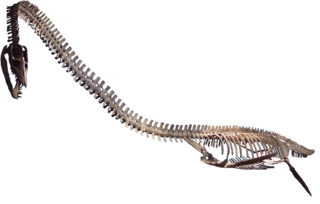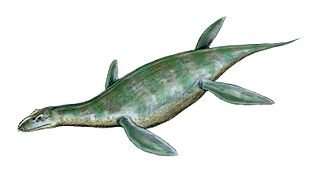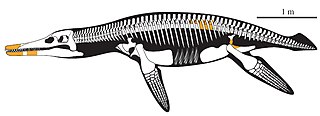
Pliosauroidea is an extinct clade of plesiosaurs, known from the earliest Jurassic to early Late Cretaceous. They are best known for the subclade Thalassophonea, which contained crocodile-like short-necked forms with large heads and massive toothed jaws, commonly known as pliosaurs. More primitive non-thalassophonean pliosauroids resembled pleisiosaurs in possessing relatively long necks and smaller heads. They originally included only members of the family Pliosauridae, of the order Plesiosauria, but several other genera and families are now also included, the number and details of which vary according to the classification used.
Liopleurodon is an extinct genus of large, carnivorous marine reptile belonging to the Thalassophonea, a clade of short-necked pliosaurid plesiosaurs. The two species of Liopleurodon lived from the Callovian Stage of the Middle Jurassic to the Kimmeridgian stage of the Late Jurassic Period. It was the apex predator of the Middle to Late Jurassic seas that covered Europe. The largest species, L. ferox, is estimated to have grown up to 6.6 metres (22 ft) in length, but could have been larger.

Elasmosauridae is an extinct family of plesiosaurs, often called elasmosaurs. They had the longest necks of the plesiosaurs and existed from the Hauterivian to the Maastrichtian stages of the Cretaceous, and represented one of the two groups of plesiosaurs present at the end of the Cretaceous alongside Polycotylidae. Their diet mainly consisted of crustaceans and molluscs.
Peloneustes is a genus of pliosaurid plesiosaur from the Middle Jurassic of England. Its remains are known from the Peterborough Member of the Oxford Clay Formation, which is Callovian in age. It was originally described as a species of Plesiosaurus by palaeontologist Harry Govier Seeley in 1896, before being given its own genus by naturalist Richard Lydekker in 1889. While many species have been assigned to Peloneustes, P. philarchus is currently the only one still considered valid, with the others moved to different genera, considered nomina dubia, or synonymised with P. philarchus. Some of the material formerly assigned to P. evansi have since been reassigned to "Pliosaurus" andrewsi. Peloneustes is known from many specimens, including some very complete material.

Umoonasaurus is an extinct genus of plesiosaur belonging to the family Leptocleididae. This genus lived approximately 115 million years ago during the Late Cretaceous period, in shallow seas covering parts of what is now Australia. It was a relatively small animal around 2.5 m (8 ft) long. An identifying trait of Umoonasaurus is three crest-ridges on its skull.

Pliosauridae is a family of plesiosaurian marine reptiles from the Latest Triassic to the early Late Cretaceous of Australia, Europe, North America and South America. The family is more inclusive than the archetypal short-necked large headed species that are placed in the subclade Thalassophonea, with basal forms resembling other plesiosaurs with long necks. They became extinct during the early Late Cretaceous and were subsequently replaced by the mosasaurs. It was formally named by Harry G. Seeley in 1874.

Thalassiodracon (tha-LAS-ee-o-DRAY-kon) is an extinct genus of plesiosauroid from the Pliosauridae that was alive during the Late Triassic-Early Jurassic (Rhaetian-Hettangian) and is known exclusively from the Lower Lias of England. The type and only species, is Thalassiodracon (Plesiosaurus) hawkinsi.

Hauffiosaurus is an extinct genus of Early Jurassic pliosaurid plesiosaur known from Holzmaden of Germany and from Yorkshire of the United Kingdom. It was first named by Frank Robin O’Keefe in 2001 and the type species is Hauffiosaurus zanoni. In 2011, two additional species were assigned to this genus: H. longirostris and H. tomistomimus.

Tatenectes is a genus of cryptoclidid plesiosaur known from the Upper Jurassic of Wyoming. Its remains were recovered from the Redwater Shale Member of the Sundance Formation, and initially described as a new species of Cimoliosaurus by Wilbur C. Knight in 1900. It was reassigned to Tricleidus by Maurice G. Mehl in 1912 before being given its own genus by O'Keefe and Wahl in 2003. Tatenectes laramiensis is the type and only species of Tatenectes. While the original specimen was lost, subsequent discoveries have revealed that Tatenectes was a very unusual plesiosaur. Its torso had a flattened, boxy cross-section and its gastralia exhibit pachyostosis (thickening). The total length of Tatenectes has been estimated at 2–3 meters (6.6–9.8 ft).

Gallardosaurus is a genus of pliosaurid plesiosaur from the Caribbean seaway. It contains the single species Gallardosaurus iturraldei. Gallardosaurus was found in middle-late Oxfordian-age rocks of the Jagua Formation of western Cuba. Gallardosaurus is believed to be evolutionarily connected to Peloneustes, a pliosaurid commonly found in the Oxfordian-aged sediment.

Neptunidraco is an extinct genus of carnivorous marine crocodyliform which lived during the middle Jurassic period in what is now northeastern Italy. It is known from a partial skeleton recovered from the nodular limestone of the Rosso Ammonitico Veronese Formation. This specimen had been provisionally referred to an unnamed species of Late Jurassic Metriorhynchus or Geosaurus. Neptunidraco was named by Andrea Cau and Federico Fanti in 2011 and the type species is Neptunidraco ammoniticus. The "Portomaggiore crocodile" is the most complete specimen of an Italian metriorhynchid to date and the oldest known metriorhynchid.

Cryonectes is an extinct genus of pliosaurid plesiosaurian known from the Early Jurassic of Normandy, northern France.

Avalonnectes is an extinct genus of small-bodied rhomaleosaurid known from the Early Jurassic period of the United Kingdom. It contains a single species, A. arturi.

Eoplesiosaurus is an extinct genus of basal plesiosauroid known from the Early Jurassic period of the United Kingdom. It contains a single species, E. antiquior.

This timeline of plesiosaur research is a chronologically ordered list of important fossil discoveries, controversies of interpretation, taxonomic revisions, and cultural portrayals of plesiosaurs, an order of marine reptiles that flourished during the Mesozoic Era. The first scientifically documented plesiosaur fossils were discovered during the early 19th century by Mary Anning. Plesiosaurs were actually discovered and described before dinosaurs. They were also among the first animals to be featured in artistic reconstructions of the ancient world, and therefore among the earliest prehistoric creatures to attract the attention of the lay public. Plesiosaurs were originally thought to be a kind of primitive transitional form between marine life and terrestrial reptiles. However, now plesiosaurs are recognized as highly derived marine reptiles descended from terrestrial ancestors.

Atychodracon is an extinct genus of rhomaleosaurid plesiosaurian known from the Late Triassic - Early Jurassic boundary of England. It contains a single species, Atychodracon megacephalus, named in 1846 originally as a species of Plesiosaurus. The holotype of "P." megacephalus was destroyed during a World War II air raid in 1940 and was later replaced with a neotype. The species had a very unstable taxonomic history, being referred to four different genera by various authors until a new genus name was created for it in 2015. Apart from the destroyed holotype and its three partial casts, a neotype and two additional individuals are currently referred to Atychodracon megacephalus, making it a relatively well represented rhomaleosaurid.

Makhaira rossica is an extinct genus and species of a marine reptile belonging to the family Pliosauridae. It lived during the early Cretaceous period, and its fossils have been found in Russia.

Arminisaurus is a genus of pliosaurid plesiosaur that lived during the Lower Jurassic in present-day Germany. With Westphaliasaurus and Cryonectes, Arminisaurus is only the third plesiosaurian taxon that was described from the Pliensbachian stage. The holotype and only known specimen is a fragmentary skeleton, comprising an incomplete lower jaw, teeth, vertebrae and elements from the pectoral girdle and the paddles. The animal had an estimated body length of 3–4 metres (9.8–13.1 ft).

Opthalmothule, was a cryptoclidid plesiosaur dating to the latest Volgian, found in the Slottsmøya Member Lagerstätte of the Agardhfjellet Formation in Spitsbergen. The type species is O. cryostea.
























